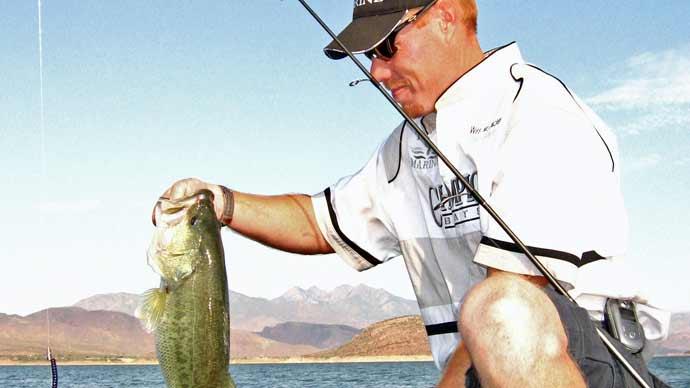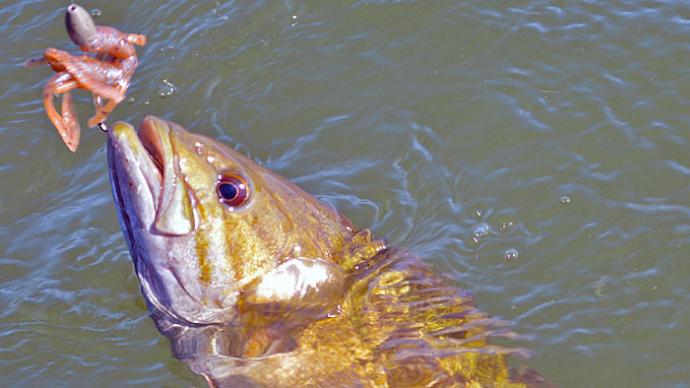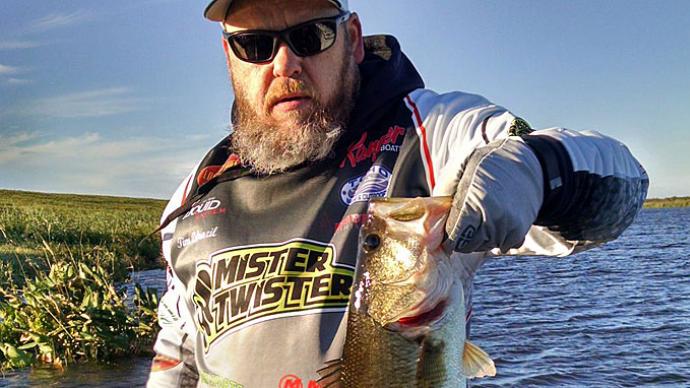
Brad Paradis’ backyard is a busy place. He lives along the St. Lawrence River in Ogdensburg, New York, not far upstream from Waddington, home base for some of the Bassmaster Elite Series’ strongest stops in recent years. Each of the giant smallmouth that competitors parade across the weigh-in stage has been an invitation for more anglers and tournaments to visit the river, which flows to the Atlantic Ocean from Lake Ontario. More anglers mean more fishing pressure.
While bass fishing remains stellar in the stretch of St. Lawrence that flows between New York and Ontario, Canada, finding something that makes pressured smallmouth bite is becoming more critical. The scent does just that, said Paradis, who competes in local, state, and regional tournaments — including cashing a check in a recent Toyota Series presented by A.R.E. North Division event on his home water. “As an angler, we are always looking for an edge,” he said. “[Scent] gives you that little extra to trick wary fish into holding on to your lure.”
Fishing scents, intended to make lures more attractive, aren’t new. Early versions were simple and included licorice-flavored anise oil and even WD-40, which had a diehard, though small, following of anglers. But they’ve taken leaps forward in recent years. They’re available impregnated in soft-plastic lures and long-lasting gels that can be applied to any hard or soft-plastic lure.
Paradis always has scent and scented lures in his boat. And while their applications are different, he said both work as described. But that doesn’t mean every angler is on board. “I can count on my hands the number of people I see scenting baits,” he said. “There are very few co-anglers [using scent] in all the different trails I fish.”
Most of that hesitation is driven by the urge to make the best use of time, whether fishing in a tournament, where more casts often equate to better finishes, or maximize precious days off work. But working scent into your presentation is a good investment. Paradis rarely casts a lure without it, believing that move will also help you catch more bass.
Successful scents
Paradis was an early adopter of scents. “When I first started fishing, I tried all of the original scents, most of which were oil-based,” he said. “I bought them all because I always try to get an advantage. Over time, you come to realize how important it is.”
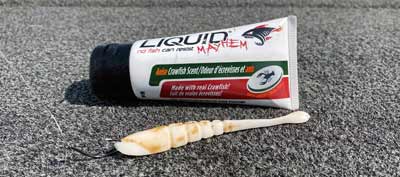
While Paradis’ catches on scented lures convinced him of its effectiveness, a report from fishing tackle manufacturer Berkley sealed the deal. It was released in 2017 when its MaxScent soft-plastic lures hit the market and explained the science behind scents.
Paradis said that while scents won’t make bass jump in your boat, they help you catch more bass in two ways. First, they make your lure seem more natural. So, when yours ends up in the mouth of a bass, it’s less likely to spit it out immediately. That gives you more time to set the hook, which means, everything else being equal, that you’ll land more bass.
The second way scents help you catch more bass is by attraction. Whether impregnated or applied, scents leave a scent trail in the water. That excites bass investigating your lure and helps others find it in heavy cover or off-colored water.
Paradis said it’s important to note that both benefits are unique to water-soluble scents. Oil-based scents don’t dissolve in water, making it extremely difficult to catch a bass’s attention. That means no scent trails, not to mention they quickly wash off lures and require frequent reapplication.
Impregnated or applied?
With a history that stretches back to at least Tom Mann’s fruit-flavored Jelly Worms, scent-impregnated soft-plastic lures received a big push forward in the late 1980s when Berkley’s PowerBait arrived on the scene. These baits have continued to evolve, and Berkley’s latest offering — MaxScent — is reaching new heights of popularity. That’s especially true of its Flat Worms wherever smallmouth lurk. “Everybody is throwing them,” Paradis said. “It’s nonstop. At every tournament, someone [at the top of the standings] is talking about them.”
Paradis said the exploding popularity of scent-impregnated soft-plastic lures is changing how some anglers fish. “A lot more people spend their entire day drop-shotting who wouldn’t before the Flat Worm came out,” he said. That’s fueling demand. MaxScent baits sell out quickly at local tackle shops, and sponsored tournament anglers tell of fellow competitors who stop by their boat pre-takeoff, asking for a bag or two.
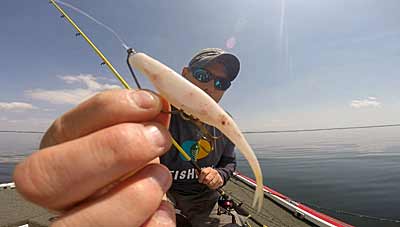
Beyond catching more bass, efficiency is the biggest benefit provided by scent-impregnated lures. When the bite is hot, there’s no need to stop to apply scent. You rig it and fish it. Paradis said most of these lures become unusable — shredded by bass and hook or lost to a snag — before their scent wears out.
Paradis said scent plays as significant a role with largemouth as it does smallmouth in certain situations. Largemouth swimming in clear water can see lures from a long distance, often committing to hitting them without hesitation. That makes scent less critical. But murky water and heavy cover, such as thick beds of aquatic vegetation, are different deals. A scent trail can help them find your lure, which they most likely won’t see until right on top.
Scent-impregnated soft-plastic lures are more popular for chasing smallmouth than largemouth. “I think it has to do with the style of baits [that are available],” Paradis said. These include finesse worms, tubes, and drop-shot baits like the Flat Worm. But choices are expanding. Berkley, for example, offers MaxScent in stick worms, jig trailers, and creature baits, all of which are better fits for chasing largemouth. It has even developed a means for adding PowerBait scent to jig skirts. “[But] there are a lot of bait companies that make non-impregnated baits,” he said.
So, he applies some when Paradis needs to fish a soft-plastic lure that’s not impregnated with scent. Picking one can be a tall task. From BANG! to Smelly Jelly, attractants are available in various flavors, consistencies, and delivery methods. And while he doesn’t have a favorite flavor — anise crawfish if push comes to shove — he does have favorite attributes. His scent needs to be a gel that’s water-soluble and long-lasting. And only a handful of fish attractants on the market, including Liquid Mayhem, offer that mix.
Paradis said Liquid Mayhem’s hydrophilic and hydrophobic properties allow it to disperse slowly. “You can still see [it on the lure], even after 30 to 40 minutes of constant fishing,” he said. “That’s one of the things that drew me to it. I don’t like spending time constantly reapplying.”
Paradis puts scent on his lures first thing in the morning. And if his plans revolve around a specific soft-plastic lure, he fills a resealable bag with a handful and a few shots of scent, kneading the two together. Then they’re ready whenever he needs one. “Time is of the essence in the middle of a tournament,” he said.
Other benefits
Scent offers advantages other than making your lure smell and taste better to bass. Early oil-based scents, for example, touted lubrication, help your lure slip through matted vegetation. And some modern water-based scents make your hard baits look better.
Paradis said some scents, such as Liquid Mayhem, have an ultra-violet light component. And while we can’t, bass see that spectrum of light. “It almost glows underwater,” he said.
Without the UV component, Paradis wouldn’t add scent to a hard bait such as crankbaits, jerkbaits, and topwaters. Their movements are designed to elicit strikes. There’s no time for a bass to mouth or inspect them. But he said a UV glow can help bass find and commit to a topwater, for example, skittering through a heavy chop.
BassResource may receive a portion of revenues if you make a purchase using a link above.


